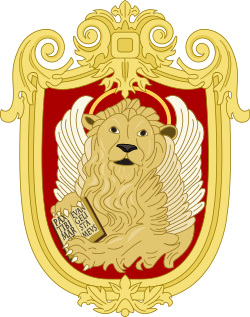
Back Nobleza veneciana Spanish Liste de familles nobles de Venise French Patriziato (Venezia) Italian Patrisiato (Venesia) VEC
The Venetian patriciate (Italian: Patriziato veneziano, Venetian: Patrisiato venesian) was one of the three social bodies into which the society of the Republic of Venice was divided, together with citizens and foreigners. Patrizio was the noble title of the members of the aristocracy ruling the city of Venice and the Republic. The title was abbreviated, in front of the name, by the initials N.H. (Nobilis Homo or Nobiluomo), together with the feminine variant N.D. (Nobilis Domina). Holding the title of a Venetian patrician was a great honour and many European kings and princes, as well as foreign noble families, are known to have asked for and obtained the prestigious title.
The patrician houses, formally recorded in the Golden Book, were primarily divided into Old Houses (Case vecchie) and New Houses (Case nuove), with the former being noted for traditionally electing the first Doge in 697 AD. The New Houses were no less significant, as many became very prominent and important in the history of the Republic of Venice. The families were furthermore divided into several other "categories", including Ducal Houses (Case ducali, whose members had become Doges), Newest Houses (Case nuovissime) raised to the patriciate in 1381, non-Venetian patrician families, and "Houses made for money" (Case fatte per soldo, usually wealthy landowning or bourgeoisie families who contributed to the state during the War of Candia and the Morean War).
Although there were numerous noble houses across Venice's Mainland Dominions and the State of the Sea, the Republic was in fact ruled as an aristocratic oligarchy by about 20 to 30 families of Venice's urban nobility, who elected the Doge of Venice, held political and military offices, and directly participated in the daily governing of the state. They were predominantly merchants, with their main source of income being trade with the East and other entrepreneurial activities, on which they became incredibly wealthy. Some of the most important families, who dominated the politics and the history of the state, include those such as the Contarini, Cornaro, Dandolo, Giustinian, Loredan, Mocenigo, Morosini and the Venier families. Nobles were forbidden by law to marry outside of the nobility, so the families intermarried within themselves, and from a young age followed the cursus honorum of Venetian noblemen, training in the army, the naval fleet, the law, and the affairs of state.
© MMXXIII Rich X Search. We shall prevail. All rights reserved. Rich X Search

